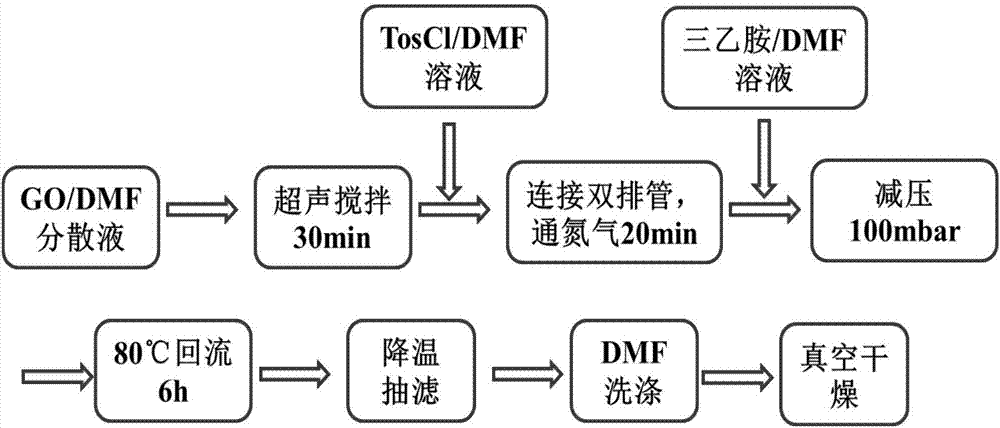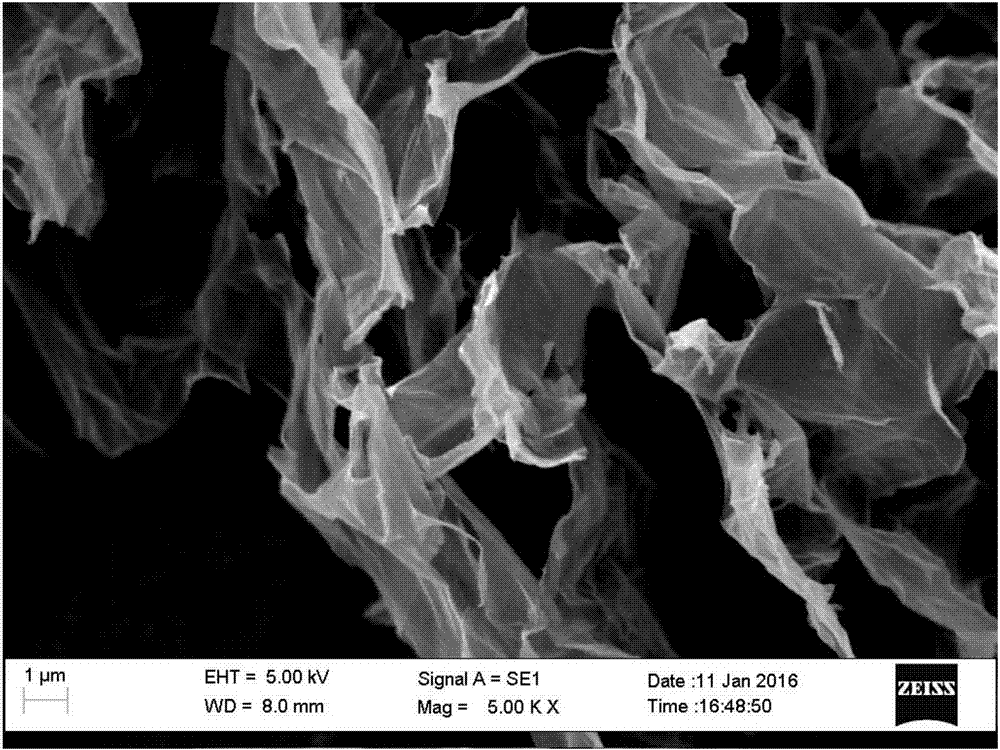Activation method of graphene oxide
An activation method and graphene technology, applied in chemical instruments and methods, inorganic chemistry, carbon compounds, etc., can solve the problems of property destruction, large steric hindrance, and damage to the lamellar structure, so as to maintain properties and save energy. Effect
- Summary
- Abstract
- Description
- Claims
- Application Information
AI Technical Summary
Problems solved by technology
Method used
Image
Examples
Embodiment 1
[0107] ①Add 0.75g graphene oxide slurry (mass fraction 28%) in a single-necked flask, add 100mL DMF, and ultrasonically stir for 30min to obtain a graphene oxide dispersion;
[0108] ②Add 9g of activated 5A molecular sieve to the graphene oxide dispersion in step ①, soak the dispersion for 24 hours and filter the dispersion into a three-necked flask;
[0109] ③Weigh 1.14g p-toluenesulfonyl chloride (the molar ratio of p-toluenesulfonyl chloride and graphene oxide is 3:1), add 10mL DMF to dissolve;
[0110] ④Under stirring condition, the solution obtained in step ③ is slowly added dropwise to the graphene oxide dispersion obtained in step ②;
[0111] ⑤Transfer the three-neck flask containing the dispersion liquid in step ④ to the oil bath, connect the condenser pipe and double-row pipe, and pass nitrogen for 20 minutes;
[0112] ⑥Weigh 1.212g of triethylamine (the molar ratio of triethylamine to graphene oxide is 6:1), add 10mL of DMF to dissolve;
[0113] ⑦Under nitrogen con...
Embodiment 2
[0126] ①Add 0.75g graphene oxide slurry (mass fraction 28%) in a single-necked flask, add 100mL DMF, and ultrasonically stir for 30min to obtain a graphene oxide dispersion;
[0127] ②Add 9g of activated 5A molecular sieve to the graphene oxide dispersion in step ①, soak the dispersion for 24 hours and filter the dispersion into a three-necked flask;
[0128] ③Weigh 1.128g of trifluoromethanesulfonic anhydride (the molar ratio of trifluoromethanesulfonic anhydride to graphene oxide is 2:1), add 10mL DMF to dissolve;
[0129]④Under stirring condition, the solution obtained in step ③ is slowly added dropwise to the graphene oxide dispersion obtained in step ②;
[0130] ⑤Transfer the three-neck flask containing the dispersion liquid in step ④ to the oil bath, connect the condenser pipe and double-row pipe, and pass nitrogen for 20 minutes;
[0131] ⑥Weigh 0.808g triethylamine (the molar ratio of triethylamine to graphene oxide is 4:1), add 10mL DMF to dissolve;
[0132] ⑦Under ...
Embodiment 3
[0136] ①Add 0.75g graphene oxide slurry (mass fraction 28%) in a single-necked flask, add 100mL DMF, and ultrasonically stir for 30min to obtain a graphene oxide dispersion;
[0137] ②Add 9g of activated 5A molecular sieve to the graphene oxide dispersion in step ①, soak the dispersion for 24 hours and filter the dispersion into a three-necked flask;
[0138] ③ Weigh 0.912g methanesulfonyl chloride (the molar ratio of methanesulfonyl chloride to graphene oxide is 4:1), add 10mL DMF to dissolve;
[0139] ④Under stirring condition, the solution obtained in step ③ is slowly added dropwise to the graphene oxide dispersion obtained in step ②;
[0140] ⑤Transfer the three-neck flask containing the dispersion liquid in step ④ to the oil bath, connect the condenser pipe and double-row pipe, and pass nitrogen for 20 minutes;
[0141] ⑥ Weigh 1.616g of triethylamine (the molar ratio of triethylamine to graphene oxide is 8:1), add 10mL of DMF to dissolve;
[0142] ⑦Under nitrogen condi...
PUM
 Login to View More
Login to View More Abstract
Description
Claims
Application Information
 Login to View More
Login to View More - R&D
- Intellectual Property
- Life Sciences
- Materials
- Tech Scout
- Unparalleled Data Quality
- Higher Quality Content
- 60% Fewer Hallucinations
Browse by: Latest US Patents, China's latest patents, Technical Efficacy Thesaurus, Application Domain, Technology Topic, Popular Technical Reports.
© 2025 PatSnap. All rights reserved.Legal|Privacy policy|Modern Slavery Act Transparency Statement|Sitemap|About US| Contact US: help@patsnap.com


